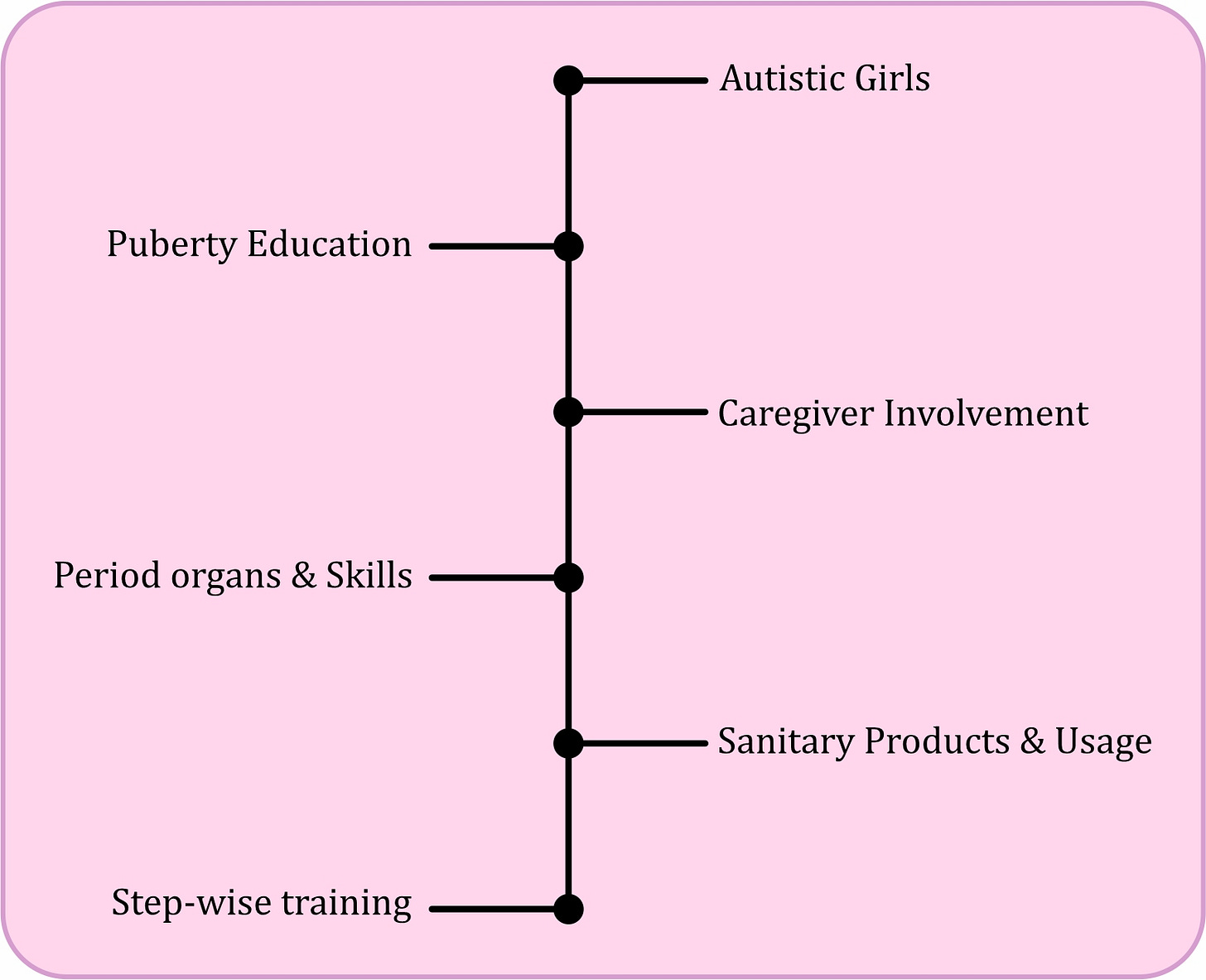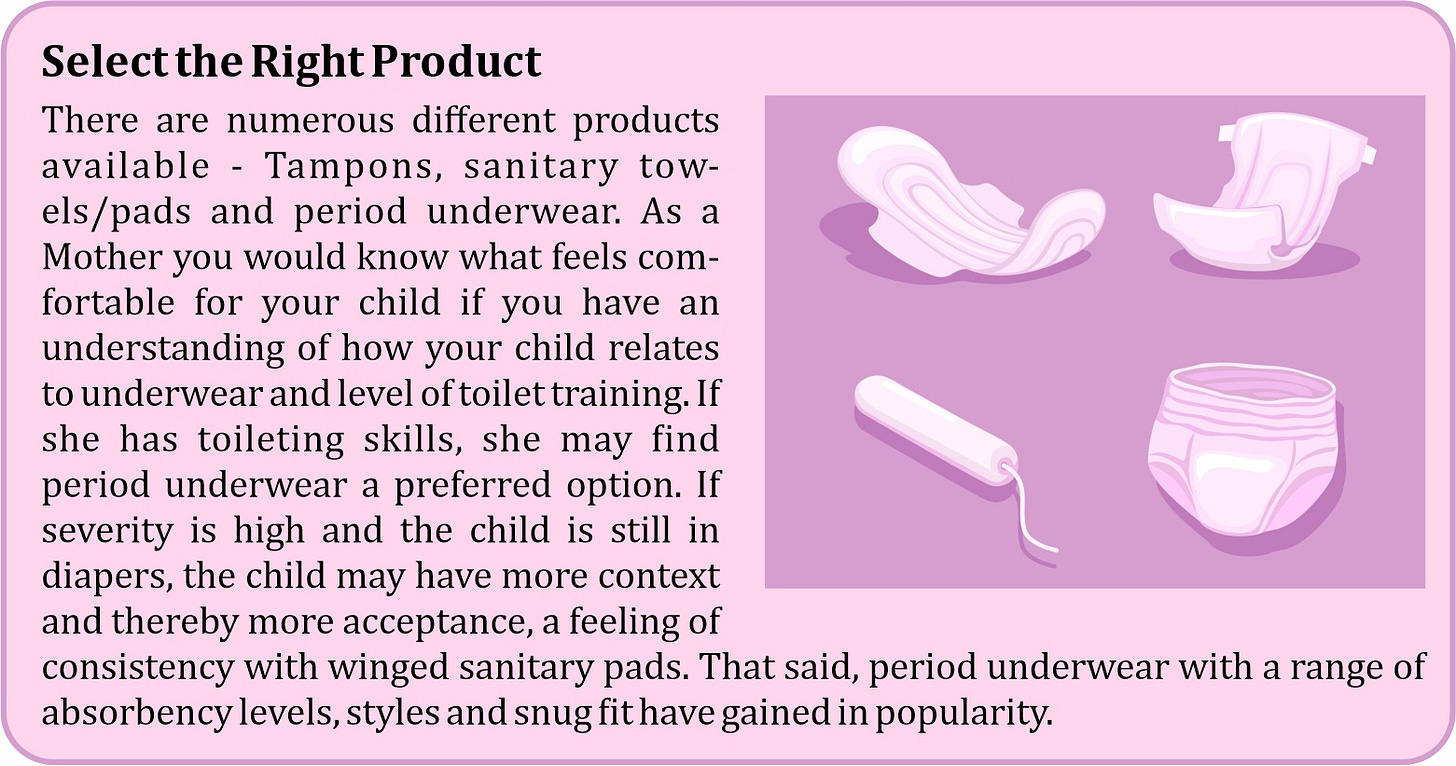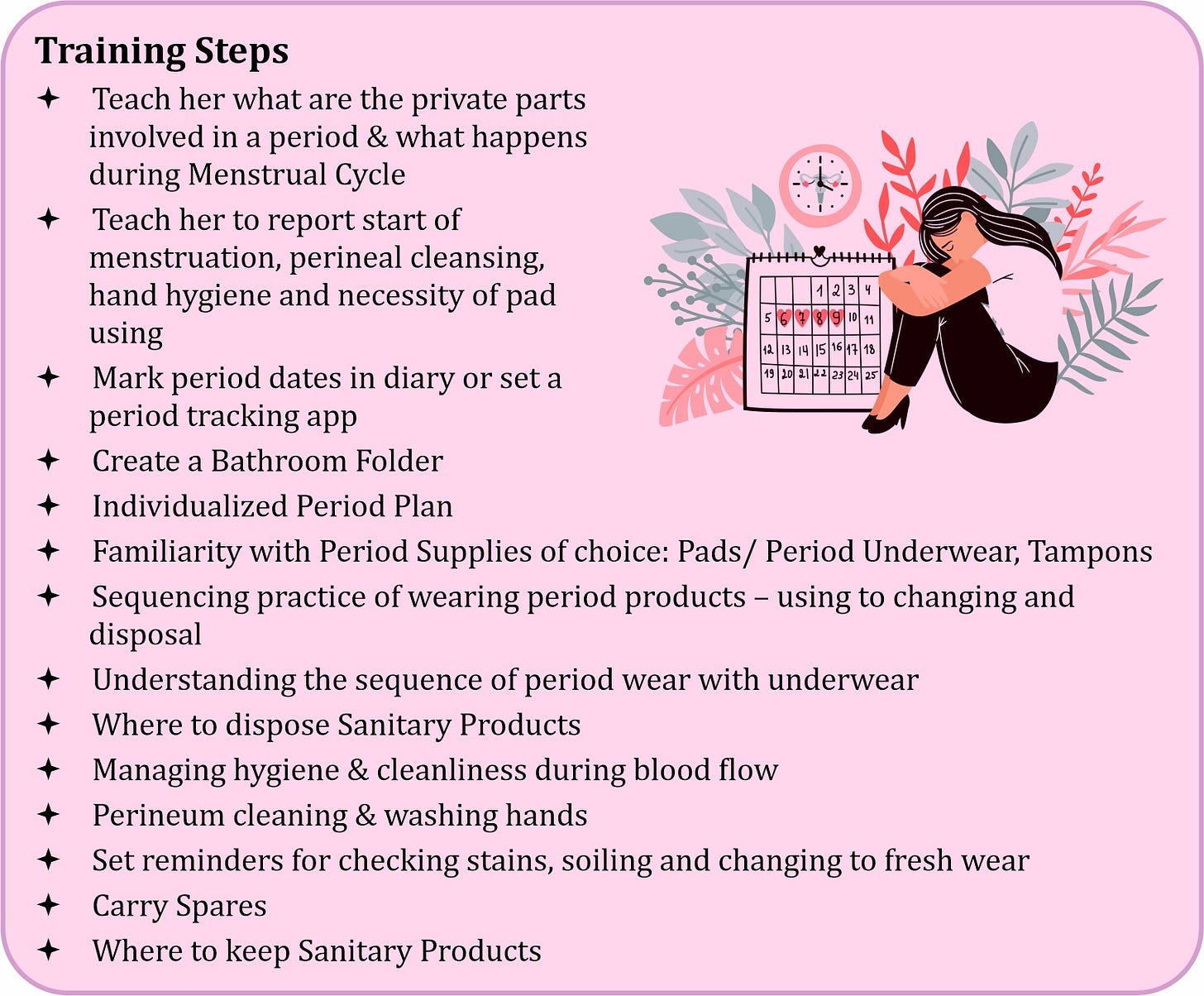Let’s Talk Menstrual Hygiene for Autistic Girls
Female genital awareness, product familiarity & acceptance, usage & disposal, perineum cleaning must become part of School-Home Menstrual Cycle Training
Even a simple action like using and changing menstrual pads can become a complex motor skill for Autistic girls. Each adolescent girl has needs specific to her because each of them has variable characteristics and different degrees of sensory and perceptual difficulties, intolerances and meltdowns. Most parents are flummoxed as to how they approach menstrual hygiene skills training. As we all know, the transitional stage between childhood and adulthood is adolescence and it is the phase of rapid physical, cognitive, emotional and social changes. Most typical adolescent girls embrace this physical and psychosocial development process with curiosity and interest, as do their families. On the other hand, transition to puberty for families with autistic girls is fraught with apprehensions. How to explain what a period is, cope with the pre-menstrual symptoms, blood flow situation, bear the odor, understand the bodily changes and use period products. In most societies, the mother is the caregiver and therefore the individualized support training designed by Educators and Occupational Therapists must be mediated through the mother with the objective that the training leads to independence of the adolescent autistic girls in their menstrual hygiene.
Many situations - dressing and undressing woes, daughters refusing to wear or throwing used sanitary wears, soiling themselves and the environment in the process - tire and strain mothers during menstruation of their girls. Collaboration is necessary for effective strategies and training. For parents responsible for carrying out Menstrual Hygiene Training, schools must provide modules, slideshow with informative videos, visual schedules and instructional resources on puberty topics. Anatomy, physical, social-emotional changes, increased hygiene responsibilities, and public versus private boundaries must become part of Special Education worksheets in IEPs. Schools have to look at menstrual training as educational content.
Any training has to be preceded by data collection involving the autism status of the adolescent (mild, moderate or severe), performance levels across cognitive, adaptive behavior, social-emotional, physical, and communication domains and menstrual pattern like frequency, duration, intensity of menstrual bleeding, whether periods are painful and regularity of the menstrual cycle.
While approaching training, the whole sequence of actions to be performed is undertaken through a combination of strategies known as task analysis and chaining. These are the fundamentals of Behavior Skills Training. A task analysis involves breaking an entire task into smaller, more manageable steps even explicitly stating the preliminary components associated with the task, such as going into the bathroom, standing near the toilet, pulling off clothing and underwear etc. This is to be used in combination with chaining procedures and prompts. Chaining is based on task analysis, in which individual steps are recognized as requirements for task mastery. For eg: an adolescent learning to wear a sanitary product would begin by taking out the product. Once this initial skill is learnt, the next step would be to learn pulling on the period underwear or fixing the sanitary pad on underwear. This technique is helpful in assisting children to learn a routine task that is repetitive, such as using the bathroom, brushing teeth, putting on clothes and shoes, or completing a work task.
A time tracker should be set by the caregiver parent for changing the sanitary pad as most would not understand the concept of soiled pads, disposal and change. It is certainly an arduous drill and caregivers have to maintain procedural fidelity to attain generalization of target skills.
Most medical researches lament the fact that there isn’t sufficient literature, that there are very few experimental studies owing to the intimate nature of the subject and parental hesitation to volunteer participation as experimental groups and control groups for such studies. Some studies found that concerned mothers request medical help to suppress or eliminate menstruation. Few good quality researches, however dwell on training methods and the efficacy of visual strategies through social stories strips, books, pictures, digital formats, modeling through dolls, video modeling in animated versions and simulations. A combination of strategies is then created to explain what are periods and step-wise hygiene management. It has to be a show and tell series, in simulated training sessions and during practical occurrence has to be initiated and taught with physical prompts. Therefore in most societies this becomes primarily a mother’s job or that of lady therapists or caregivers.
All of the above may seem extremely complicated and impossible to the autistic teen. Sensory sensitivity to the smell and sight of menstrual blood can lead to emotional self-regulation hitting the nadir, an inability to calm down and consequent meltdowns. Changes in showering and toileting routines, having to wear period products, hand hygiene, and the use of public toilets during the cycle does create anxiety spells for the adolescent and the caregiver. Executive functioning difficulties that autistics face can make learning the sequence of changing a sanitary pad and perineum cleaning a mammoth task. Interoception or the ability to process one’s bodily state does get maxed out by communication deficits. There are high possibilities of aggravated problem behaviors during premenstrual syndrome, a combination of physical and psychological factors.
Therefore the training has to be delivered gently with a lot of handholding in the literal sense. Young girls who are to be beneficiaries of the training process cannot be in the background; the caregiver should be focused on progression to the next step and achieving the ability to complete all hygiene-related tasks and multi-step directions independently.
Migration to verbal instructions and independence is achieved in Stage II & III of the training process. The training frequency and duration is to be individualized and must take into consideration whether the autism is mild, moderate or severe. Those who have daily self-care abilities, general hygiene and are able to dress independently will be able to learn faster than those who do not. Therefore, developing toilet habits, getting dressed and acquiring ADLs in early developmental stages are prerequisites for preparing autistic girls for menarche. How many steps the adolescent girl is able to comprehend and do will settle the menstrual hygiene scores and support requirements. The scoring is to be done on the basis of self-reporting, parental and caregiver interviews.
Menstruation management is complex and must be treated as a priority self-care skill to be acquired for the autistic girls to continue their lives as healthy adolescents.
Conclusion
For a girl getting her period can bring challenges whether or not one is autistic. But autistic girls experience challenges amplified beyond the usual. And unlike typically developing teens, they are less likely to have the support of peers due to social difficulties. Autistic people can need time to adjust to and understand changes, so it is important to start early with preparing for menstruation. Clear descriptions and explanations of what is going to happen when their period starts and what they need to do to manage it will help to avoid confusion and unnecessary stress. The information should be delivered in a format that is most suited to the individual in simple, basic language and must be accurate, explicit with detailed information on the physiology of periods, the sanitary protection available and how to use them. There is no need to be vague or embarrassed by something that is natural. As with all ADL drills, repeated trials and practice makes subsequent mobilization to the task smooth. Always remember, that poor self-care skills further squeeze already limited possibilities of social interactions for autistics. All trainings must be laced with ice-breaking interactions.
Finally, there is limited academic work in this field, studies should be undertaken to reveal the voices of autistic adolescents on their menstruation and puberty experiences through experimental group research design.







